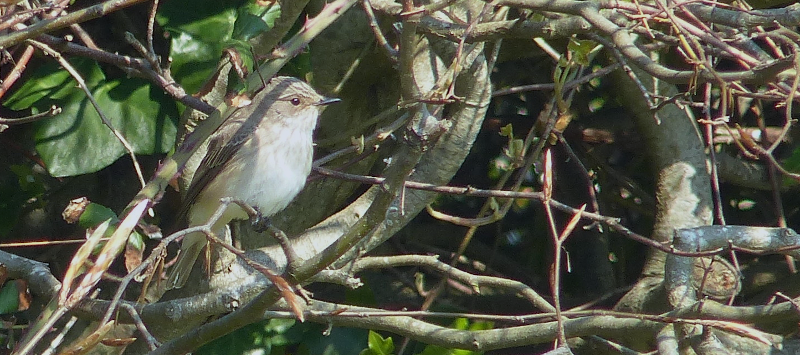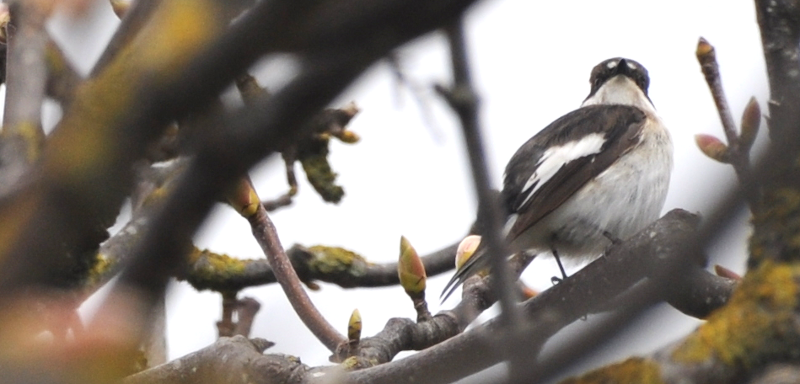Average Birding

Portland, Spring 2021, Part #4
To the island of Portland we have gone. In this post we recount the events of day seven of the trip, May 1st 2021.
All good things...
And now we must go home. Boo. Before we do though, let's pay another visit to Portland Castle; it was great yesterday, perhaps it will be again.
Spoilers: it is. There are fewer Willow Warblers, but our Spotted Flycatcher and Common Redstart friends still show very well, often within a couple of metres of each other in the same hedge.

A hurried looking birder turns up half-way through and asks us if we've found Pied Flycatcher. We have not. They have apparently been reported again. What are we missing here?
A tree to our immediate left, it turns out; in focussing on the bits of the garden that we aren't near, we were apparently not paying enough attention to the big tree sheletering the English Heritage information hut. In which a male Pied Flycatcher is majestically sitting. Just as we get on to it properly, it zips out of the tree, and out of the garden entirely. Perhaps into the little collection of conifers just outside. Interesting, that's not where I'd expect it to be. We'll perhaps take a closer look in there in a bit.
Our hurried friend does a complete lap of the garden, car park and outside in the space of half an hour and is then gone. Efficiency is obviously on his mind! It isn't for us - we're definitely in loafing birder mode. We have a trip round to the walled area to check on the Willow Warbler lawn - it isn't quite as busy as yesterday, but it's still pretty good.
As we return through the wall's portal, I make an attempt to photograph one or two of the Willow Warblers feeding in the trees above. This involves a lot of standing still and hope. And not a lot of success. As I sidle through the portal though, a female Pied Flycatcher suddenly alights on a twig perhaps three or four metres away, and shows no signs of being perturbed by me pointing a camera at her.

We do eventually have to leave the walled area and disturb the bird - it flaps its way out of the garden entirely into the same conifers the male did maybe forty minutes ago; our resolve to investigate is strengthened.
We make our way back out of the garden and through the various gates, then do a quick tour of the stubby little trees in the plaza outside. What we find to start with are House Sparrows and Goldfinches to start with, but, typically, in the last tree, we find the female Pied Flycatcher again. She pokes about a bit, before switching to a different tree - and in there we also find her counterpart. Well then.
After a while the male flycatcher hops out of the conifers and returns to the hut guarding tree, satisfied that the garden can once again be his undisturbed domain - we take a bit more time taking a look at him in slightly better light before deciding we really ought to be making tracks.

A sneaky trip to the New Forest
We do manage one more little jaunt on our way home. We peel off the A31 as we enter the New Forest, and head North, past Fordingbridge, and the amusingly named Sandy Balls holiday village. A short drive along the B3078 later, we're parked up on Godshill ridge with a great view over some open heathy bits.
Our plan here is to walk out to Pitts Hill enclosure and back, with a vague hope of catching up with long time bogey bird, Lesser-spotted Woodpecker. Probably fat chance, but it's got to be tried.
We trundle out through the gorse and immediately come across multiple Stonechat and Linnet on the tops. Good start.

As we climb Cockley hill, there's a little thicket of trees to our left, and as we approach, a male Common Redstart flaps between a standalone tree next the the path and the top of one of the larger deciduous trees at the edge.

We keep track of this bird as it sings a bit from the top, then descends into a more sheltered bit of cover in five or six holly trees next door. It does some classic Redstart on a low-down dark twig posing for us. A bit of activity higher up in the same tree finds us the female, too. Redstarts. What absolutely solid little birds they are.

Higher up there's more Common Redstart excitement - this time, a pair of males are having a mid-air argument about which of them is the boss of an even smaller clump of trees. We take a seat to watch this, and are left gobsmacked as person after person steadily ignores this spectacle, and then eventually, one walks close enough to the fight to split it up. Is this a normal thing for round here, or did all the bird curiosity on the South coast get accidentally concentrated in Dorset?
We waltz on into the more heavily wooded and are greeted by a Treecreeper. We also hear a Willow Warbler singing clearly, and remark that it's a cool thing to have seen so many on Portland, but to only hear one sing for the first time here. In the distance - a hint of Cuckoo, perhaps?
We make our way through the wood, traversing a couple of areas at the edge that look like they ought to be good for Redstart again. Nothing doing though. Heading back in, we reach a fork in the path. Both paths are good - the left one looks perhaps more sheltered, so we'll try that way. Five steps down the path, a Cuckoo loudly calls from somewhere off to the right. With much eye rolling, we reverse course and take the right fork.
This path gently slopes downward. Off to the right, there's a slightly more open area with a watercourse heading through it, and what looks like a pond or two. Several birches at various stages of life are unevenly distributed in it. The cuckoo calls again - it's still further down the hill from us, we'd guess, in an area which is screened from us by the considerably thicker trees next to the path. We look down the path, and guess there might be a better view a little bit further down.
The Cuckoo keeps calling as we walk behind the screen of trees, so when we look out we know roughly where to look. "Cuckoo!" Ah - that'd be it sitting on that dead birch tree over there then. "Cuckoo! Cuckoo!" Ok, we get it. This isn't a bad view for a Cuckoo - you can easily hear them all day and never see them - but it's still far away. It changes trees a few times, still calling, but each place it tries is too distant for even a hope of getting a photo. Still, to clap eyes on one is always a treat.
Not a lot else happens in the wood - we spy a few Long-tailed Tits high up in the canopy, but that's about it. Only a slightly tricky crossing of a tiny stream in our path is worthy of mention on the traipse back to the car.